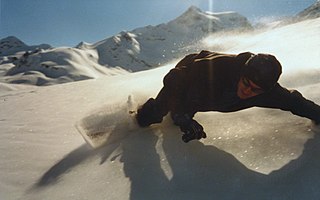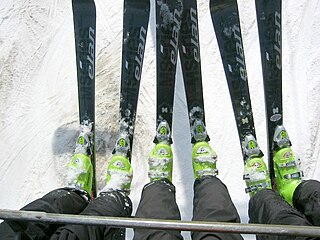
Snowboards are boards where the user places both feet, usually secured, to the same board. The board itself is wider than most skis, with the ability to glide on snow. Snowboards widths are between 6 and 12 inches or 15 to 30 centimeters. Snowboards are differentiated from monoskis by the stance of the user. In monoskiing, the user stands with feet inline with direction of travel, whereas in snowboarding, users stand with feet transverse to the longitude of the board. Users of such equipment may be referred to as snowboarders. Commercial snowboards generally require extra equipment such as bindings and special boots which help secure both feet of a snowboarder, who generally ride in an upright position. These types of boards are commonly used by people at ski hills, mountains, backcountry, or resorts for leisure, entertainment, and competitive purposes in the activity called snowboarding.
A ski is a narrow strip of semi-rigid material worn underfoot to glide over snow. Substantially longer than wide and characteristically employed in pairs, skis are attached to ski boots with ski bindings, with either a free, lockable, or partially secured heel. For climbing slopes, ski skins can be attached at the base of the ski.

A personal watercraft (PWC), also called water scooter or jet ski, is a recreational watercraft that a rider sits or stands on, not within, as in a boat. PWCs have two style categories, first and most popular being a runabout or "sit down" where the rider uses the watercraft mainly sitting down, and the watercraft typically holds two or more people. The second style is a "stand-up", where the rider uses the watercraft standing up. The stand-up styles are built for one rider and are used more for doing tricks, racing, and use in competitions. Both styles have an inboard engine driving a pump-jet that has a screw-shaped impeller to create thrust for propulsion and steering. Most are designed for two or three people, though four-passenger models exist. Many of today's models are built for more extended use and have the fuel capacity to make long cruises, in some cases even beyond 100 miles (161 km).
Elan is a Slovenian company, located in Begunje na Gorenjskem, specializing in the production of sporting goods. It is best known for its skis and snowboards. Other products include sailboats from 30 to 50 ft length, motor yachts, apparel, and equipment for sports facilities. The brand became better known in the late 1970s, when Swedish alpine skiing ace Ingemar Stenmark won three consecutive World Cup overall titles on Elan skis. The company also manufactured license-built DG gliders from 1978.

Freeriding is a style of snowboarding or skiing performed on natural, un-groomed terrain, without a set course, goals or rules. It evolved throughout the sport's formative early years as a contrary response to the highly regimented style of ski competition prevalent at the time. Snowboarders primarily refer to freeriding as backcountry, sidecountry, or off-piste snowboarding, and sometimes big mountain or extreme riding.

Freeskiing, or new school skiing, is a specific type of alpine skiing, which involves tricks, jumps, and terrain park features, such as rails, boxes, jibs, or other obstacles. This form of skiing resulted from the growth of snowboarding combined with the progression of freestyle skiing. "Newschoolers", or those who specifically ski in this style, as opposed to traditional freestylers, freeriders, big mountain skiers, and racers, are often found in terrain parks, which are designed specifically for tricks.

A carved turn is a skiing and snowboarding term for the technique of turning by shifting the ski or snowboard onto its edges. When edged, the sidecut geometry causes the ski to bend into an arc, and the ski naturally follows this arc shape to produce a turning motion. The carve is efficient in allowing the skier to maintain speed because, unlike the older stem Christie and parallel turns, the skis don't create drag by sliding sideways.

Ski geometry is the shape of the ski. Described in the direction of travel, the front of the ski, typically pointed or rounded, is the tip, the middle is the waist and the rear is the tail. Skis have four aspects that define their basic performance: length, width, sidecut and camber. Skis also differ in more minor ways to address certain niche roles. For instance, skis for moguls are much softer to absorb shocks from the quick and sharp turns of the moguls and skis for powder are much wider to provide more "float" in deeper, softer snow.

A modified version of their alpine counterparts, twin-tip skis are designed to enable a skier to take off and land backward while jumping and to ski backwards (switch) down a slope. The name "twin-tip" comes from the dual shape of the ski. While most alpine skis have a defined, curved-up front end as well as a flat rear end, twin-tip skis have a curved-up tip and tail.
Lib Technologies is an American snowboard manufacturer known for its radically innovative approach to snowboard design. Often referred to as Lib Tech, the company falls under the umbrella of parent company Mervin Manufacturing. Surf company Quiksilver bought Mervin in 1997. As of 2013, Mervin was purchased by Altamont Capital Partners.

GT Bicycles is an American company that designs and manufactures BMX, mountain, and road bicycles. GT is a division of the Dutch conglomerate Pon Holdings, which also markets Cannondale, Schwinn, Mongoose, IronHorse, DYNO, and RoadMaster bicycle brands; all manufactured in Asia.

Candide Thovex is a French professional skier, filmmaker and entrepreneur. He is known for his creative freestyle skiing movies and professional accomplishments. He first caught the attention of the world of outdoor and action sports by jumping Chad's Gap, a massive transfer jump of 120 feet (37 m) from take-off to landing over a 40 feet (12 m) deep gully in Alta, Utah, US. His point of view videos routinely go viral on the internet and are viewed by tens of millions. He is widely considered to be one of the best freeskiers in the history of the sport.
Seth Morrison is a professional skier. He has won many competitions and has appeared in a number of ski movies. He is best known for jumping off cliffs from extreme heights.

Developed during the winter of 1996 by Martin and Erik Fey, the Teleboard consists of a long, narrow snowboard, or wide ski, with two free-heel telemark bindings arranged one in front of the other at a slight angle to the longitudinal axis. This is similar to a skwal which uses fixed-heel bindings mounted in line with each other.

Backcountry snowboarding is snowboarding in a sparsely inhabited rural region over ungroomed and unmarked slopes or pistes in the backcountry, frequently amongst trees, usually in pursuit of fresh fallen snow, known as powder. Often, the land and the snow pack are not monitored, patrolled, or maintained. Fixed mechanical means of ascent such as ski lifts are typically not present, but alternative means such as splitboarding, hiking, snow shoeing and helicopters ("heliskiing") are sometimes used to reach the mountain's peak.

Line Skis, commonly shortened to Line or stylized as LINE, is a new school skis company owned by K2 Sports. Line Skis was founded by Jason Levinthal in 1995 to produce short, twin-tipped skis for freestyle skiers, and has since moved to produce full-length freeskis.

The SCX, for "SideCut eXtreme", was an alpine ski introduced by Elan in the winter of 1993/4. Skis before the SCX had almost always used a shape that was slightly curved inward on the sides, typically by 7 millimetres (0.28 in) compared to a straight line running from tip to tail. The SCX was designed with over 22 millimetres (0.87 in) "sidecut", producing a wasp-waisted ski unlike anything on the market.

Ultimate Rush is a 2011/2012 documentary television series produced by the Red Bull Media House in association with Matchstick Productions, and marketed as a combination of stupendous action sports endeavour, coupled with a cinematic-approach to storytelling. Through its wide distribution in the United States, the United Kingdom, Brazil, Denmark, Austria and other territories, the series is evidence of the acceptance of extreme sports into mainstream television, and one of the most complete accounts thereof. The series focuses on the outrageous exploits of some of the best athletes in the world, and how they explore the fine line between extreme sports, philosophy and art. Most of the filming was conducted in the rugged backcountry of British Columbia, Alaska, the Rocky Mountains, the French Alps, the Himalayas and the Andes, but not at official events or secured sites.
Eric Pollard is an American snow freeskier and film editor from Welches, Oregon and currently resides in the Hood River region of Oregon. He was a professional skier for Line Skis for over 22 years and now designs skis and snowboards for Season. Always challenging the status quo, he has innovated outerwear, accessories and hard goods for FW Apparel, Anon Optics, Dakine, K2, Causwell and Hest.
The Faction Collective is a manufacturer of freeride skis, poles and skiing-related products, based in Verbier, Switzerland. The company's products are sold in over 31 countries through their website and through distributors.














